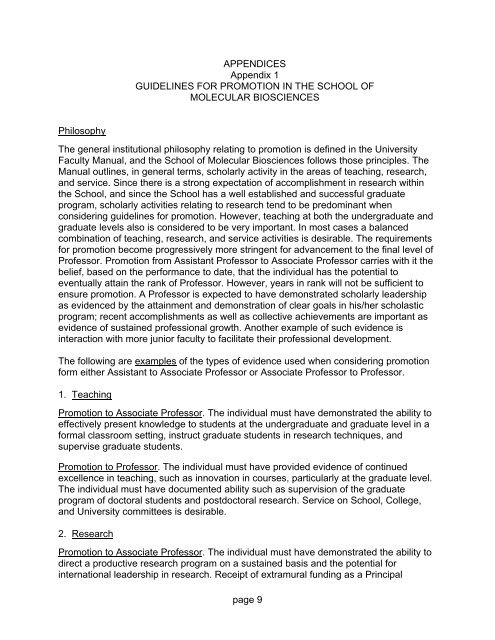2005 - Smb.wsu.edu - Washington State University
2005 - Smb.wsu.edu - Washington State University
2005 - Smb.wsu.edu - Washington State University
Create successful ePaper yourself
Turn your PDF publications into a flip-book with our unique Google optimized e-Paper software.
Philosophy<br />
APPENDICES<br />
Appendix 1<br />
GUIDELINES FOR PROMOTION IN THE SCHOOL OF<br />
MOLECULAR BIOSCIENCES<br />
The general institutional philosophy relating to promotion is defined in the <strong>University</strong><br />
Faculty Manual, and the School of Molecular Biosciences follows those principles. The<br />
Manual outlines, in general terms, scholarly activity in the areas of teaching, research,<br />
and service. Since there is a strong expectation of accomplishment in research within<br />
the School, and since the School has a well established and successful graduate<br />
program, scholarly activities relating to research tend to be predominant when<br />
considering guidelines for promotion. However, teaching at both the undergraduate and<br />
graduate levels also is considered to be very important. In most cases a balanced<br />
combination of teaching, research, and service activities is desirable. The requirements<br />
for promotion become progressively more stringent for advancement to the final level of<br />
Professor. Promotion from Assistant Professor to Associate Professor carries with it the<br />
belief, based on the performance to date, that the individual has the potential to<br />
eventually attain the rank of Professor. However, years in rank will not be sufficient to<br />
ensure promotion. A Professor is expected to have demonstrated scholarly leadership<br />
as evidenced by the attainment and demonstration of clear goals in his/her scholastic<br />
program; recent accomplishments as well as collective achievements are important as<br />
evidence of sustained professional growth. Another example of such evidence is<br />
interaction with more junior faculty to facilitate their professional development.<br />
The following are examples of the types of evidence used when considering promotion<br />
form either Assistant to Associate Professor or Associate Professor to Professor.<br />
1. Teaching<br />
Promotion to Associate Professor. The individual must have demonstrated the ability to<br />
effectively present knowledge to students at the undergraduate and graduate level in a<br />
formal classroom setting, instruct graduate students in research techniques, and<br />
supervise graduate students.<br />
Promotion to Professor. The individual must have provided evidence of continued<br />
excellence in teaching, such as innovation in courses, particularly at the graduate level.<br />
The individual must have documented ability such as supervision of the graduate<br />
program of doctoral students and postdoctoral research. Service on School, College,<br />
and <strong>University</strong> committees is desirable.<br />
2. Research<br />
Promotion to Associate Professor. The individual must have demonstrated the ability to<br />
direct a productive research program on a sustained basis and the potential for<br />
international leadership in research. Receipt of extramural funding as a Principal<br />
page 9


